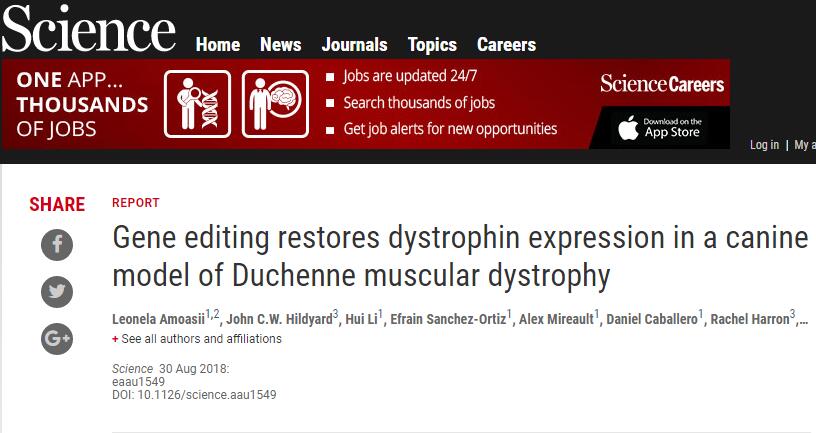According to a study published in the August 30 issue of Science, scientists from Southwestern University of the United States successfully used the CRISPR-Cas9 gene editing technology to successfully improve four dogs with Duchenne muscular dystrophy (DMD). Muscle protein levels. This research is expected to accelerate similar clinical trials to treat this deadly muscle wasting disease. DMD is a rare genetic disease that occurs mainly in boys. About one in every 3,500-5,000 boys suffer from DMD. Usually, the muscles of the patient gradually weaken from childhood, and often have to be in a wheelchair during adolescence. Even wearing a respirator, but eventually will die prematurely at the age of 30 because of heart or diaphragm failure. DMD is caused by mutations in the muscle cells of patients with little or no dystrophin (Dys), and Dys can help muscles absorb shocks and protect them from damage, which is essential for the normal function of muscles. Although scientists have known the cause of DMD decades ago, no effective treatment has been developed. If the method of using CRISPR-Cas9 proves to be effective in human trials, it may fundamentally change the disease status of patients with DMD. Southwestern's research team genetically edits the muscle cells of DMD puppies to eliminate the key barriers to protein production—a small piece of protein-coding DNA found in both dogs and humans. In order to implant this gene editing technology into the muscles of dogs, Dr. Eric Olson, a molecular biologist and senior research author at Southwest University, and his colleagues designed a harmless virus, adeno-associated virus (AAV), as a vector. The DNA of part of the virus itself is stripped out to make room for the gene editing component. Some viruses carry the Cas9 molecular "scissors" to cut off DNA sequences that block the production of Dys in muscle cells, while others carry a guide molecule to help Cas9 determine the site of the desired cleavage. Within about two months after the intervention, more Dys was produced in the muscle tissue of the dog's body. Depending on the type and dose of the muscle, the level of Dys in the muscle connected to the bone rose to 3% to 90% of the normal level. In the myocardium, the key target of treatment, its level rose to 92%, and in the diaphragm it also rose to 58%, and Dys is almost non-existent in the DMD population. This study demonstrates that CRISPR can be used to treat DMD in rodents and human cells in the laboratory, which is the first successful in large mammals. In this study, the team focused on measuring the recovery of protein levels and has not explored the effects of this intervention on dog behavior and daily life. The researchers said that no unexpected changes have been found in other areas of the genome (gene editing techniques are often a concern), but there is no evidence that the technology will make dogs sick. It is unclear how long a single infusion of CRISPR gene editing can last in DMD patients. Olson and his colleagues hope that this intervention can be durable enough only once, but they need further research to get more clarity. The idea. Elizabeth McNally, a genetics cardiologist at the Center for Genetic Medicine at Northwestern University, said that if multiple treatments are needed over time, patients may not be able to use the same viral vector. "The human body may produce the corresponding neutralizing antibodies, so there are still many problems with the use of viral transmission." Currently the only approved DMD treatment for the US market - a drug that requires continuous infusion, Exondys 51 (eteplirsen) - can help Dys levels rise moderately, approved in September 2016, but the drug's efficacy is rather vague And was explicitly rejected by the FDA expert committee, but in the end it was unexpectedly approved by the FDA. This method differs from Olson in that it acts on RNA and does not alter abnormal DNA sequences and therefore requires constant reintroduction to ensure healthy Dys production. The treatment company Sarepta Therapeutics has not yet expressed its views on this new study. DMD researcher, Amy Wagers, a professor of stem cell biology and regenerative medicine at Harvard University (not involved in both therapies), said both treatments have the potential to promote the secretion of Dys. “It is very exciting to study success in large mammals, but the authors also very well pointed out that this is a preliminary study of a small number of animals with a short follow-up period.†Dr. Leonela Amoasii, the lead author of the study and assistant lecturer in molecular biology at Olson Laboratory, said, “We still have a lot of work to do before clinical application.†The lab plans to conduct longer-term studies to measure Dys levels. Whether it can be stable and ensure that gene editing does not cause side effects. Frozen Seafood Mix,Mixed Seafood Bags,Frozen Seafood Mix Bags,Frozen Seafood Cocktail Zhoushan Haiwang Seafood Co., Ltd. , https://www.haiwangseafoods.com